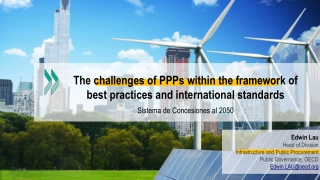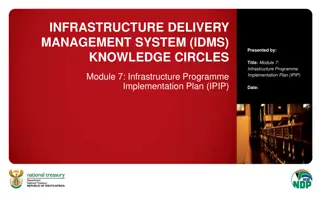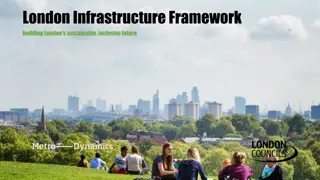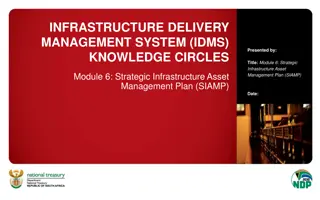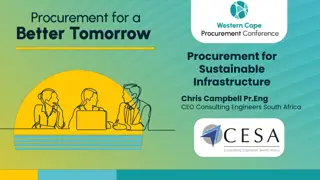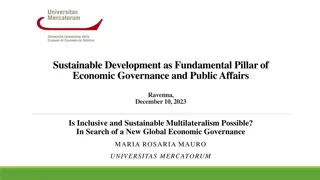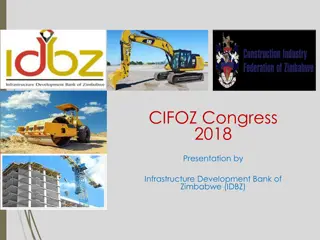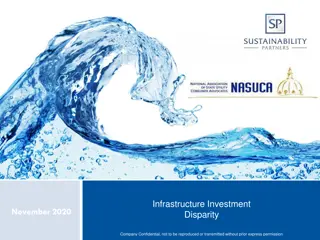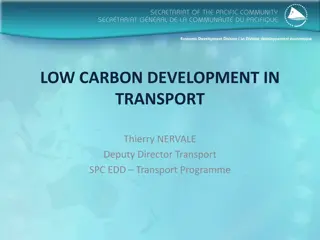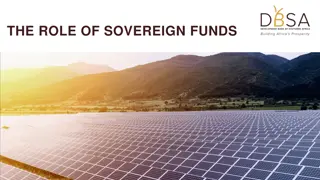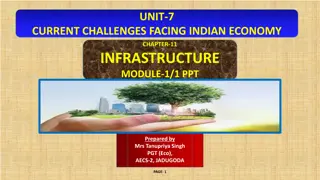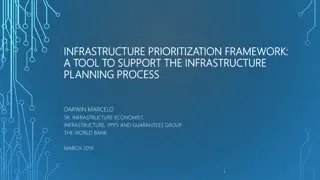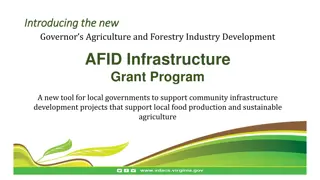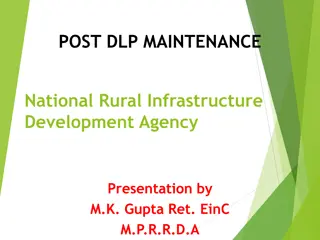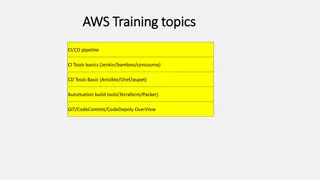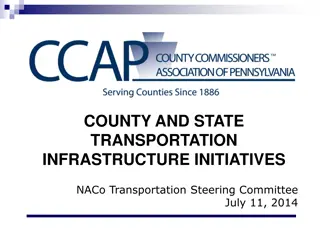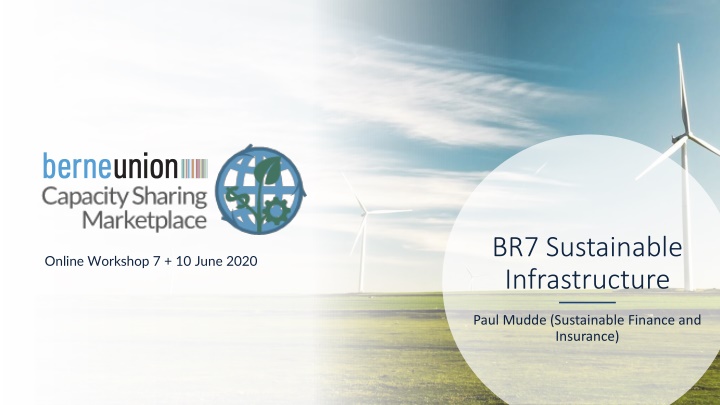
BR7 Sustainable Infrastructure
This online workshop focuses on improving the bankability of sustainable infrastructure projects in challenging markets. Explore recommendations to enhance sustainability, seize market opportunities, and assess the efficacy of traditional lending and insurance schemes. Understand key risk mitigation products and potential partners for cooperation in less developed and high-risk markets, including public and private entities.
Download Presentation

Please find below an Image/Link to download the presentation.
The content on the website is provided AS IS for your information and personal use only. It may not be sold, licensed, or shared on other websites without obtaining consent from the author. If you encounter any issues during the download, it is possible that the publisher has removed the file from their server.
You are allowed to download the files provided on this website for personal or commercial use, subject to the condition that they are used lawfully. All files are the property of their respective owners.
The content on the website is provided AS IS for your information and personal use only. It may not be sold, licensed, or shared on other websites without obtaining consent from the author.
E N D
Presentation Transcript
BR7 Sustainable Infrastructure Online Workshop 7 + 10 June 2020 Paul Mudde (Sustainable Finance and Insurance)
BR7 Sustainable Infrastructure This breakout will look at the developing recommendations to improve the bankability of sustainable infrastructure projects in challenging markets, and how project sponsors can work with public and private financiers to achieve this. MIGA and WBG s work on sustainability and climate change Challenges for bankability in sustainable infrastructure What recommendations / templates / examples could improve this? How to seize opportunities in these markets for such projects? Are traditional lending and insurance schemes still working for such projects? 2
Definitions & Concepts Less developed and high risk markets: IBRD Low Income Countries (LICs) Countries in OECD Risk category 7 Countries that fall under IMF/WB DSF and OECD sustainable lending guidelines Distinction between public and private infrastructure projects: Public: Sovereign projects: (Ministry of Finance / Central Bank) Sub-sovereign projects (e.g. Municipality, Province) State Owned Enterprises (e.g. public utility company owned by government) Private: Corporate projects (Existing private company) Greenfield Project Finance Projects with Special Purpose Company as borrower). 3
Definitions & Concepts Key risk mitigation / enhancement products: Classical political risk insurance (e.g. war, expropriation, transfer and inconvertibility) Extended Political risk insurance Classical PRI + Breach of contract cover, used in PPP project finance) Comprehensive credit insurance / enhancement : Covering both commercial and political risks Potential partners for cooperation in less developed and high-risk markets: A. Public / official partners: Multilateral Development Banks (e.g. IBRD/IDA, IFC, ADB, EBRD, IaDB, IsDB, AfDB) Bilateral Development Banks (e.g. KfW/ DEG, FMO, CDC, USDFC, Proparco, OE Specialised Multilateral Insurers (e.g. MIGA, ATI, ICIEC, Dhaman) Official ECAs / EXIM banks (e,g, USEXIM, UKEF, BPI France, SACE, EDC, NEXI, Ksure, SINOSURE) ODA Aid Agencies (e.g. ministries of development cooperation or their agencies: JICA, KOICA, SIDA, USAID, DANIDA Other? B. Private partners: Commercial Banks (international and local) Institutional Investors (international and local) Private Insurers (e.g. Lloyds, Chubb, AXA XL, AIG, Zurich) Private Philanthropy Foundations (e.g. Rockefeller Foundation, Bill and Melinda Gates Foundation) Project Sponsors/ Equity Investors Exporters NGOs Other? 4
Definitions & Concepts Blended Finance: OECD Defines Blended Finance as the strategic use of development finance for the mobilisation of additional finance towards sustainable development in developing countries, where additional finance refers to commercial finance that does not primarily target development outcomes in developing countries, while development finance is public and private finance that is being deployed with a development mandate. Examples: Syndicated loans (e.g. A/B loans) ODA guarantees (e.g. ODA 1st loss guarantees) IDA 1st loss guarantees for MIGA for projects in certain high-risk markets (e.g. IDA MGF for Private Sector projects) Interest rate subsidies for concessional loans to sovereign borrowers in IMF/WB DSF countries Equity investments 5
Key discussion themes: I. Experiences with tackling these challenges? Cooperation with public / private partners? Use of blended finance concepts? Examples? Key lessons learned? Any recommendations? Key challenges for bankability of sustainable infrastructure (public / private sector projects)? II. Could 1st loss guarantees help in supporting public or private sector infrastructure projects in high-risk markets? Who could provide such 1st loss guarantees? Could 1st loss guarantees trigger more capacity/ capital and better terms and conditions from potential public / private partners ? (lower insurance premium / interest rates, more insurance/finance capacity, longer tenors) 1st loss guarantees (public and private sector projects) III. Do you have any recommendations for enhanced cooperation between public and private partners to increase the number of bankable infrastructure projects in high-risk markets? Experience with public sector projects in IMF/WB DSF countries for which concessional finance is required? IV. Are traditional lending / insurance schemes still working for public / private sector projects in high-risk markets? Are any changes needed in OECD Arrangement on officially supported export credits or other international regulations (e.g. BIS capital requirements framework, TOSSD framework, mobilisation measurement systems, OECD DAC ODA Framework) to support the financing / insurance of infrastructure projects in high-risk markets? Are there any organisational incentives to seek cooperation with other public or private partners in high-risk markets? Regulatory challenges and organisational incentives V. Other ideas/ suggestions? 6
Key discussion themes: Introduction MIGA and WBG s work on sustainability and Climate Change. Merli Baroudi, director Economics and Sustainability of MIGA. 7
Annex A. List of Registered Participants Annex A. List of Registered Participants Investment in sustainable infrastructure - 9th June Name Job title Company 1DANIEL WAGNER Senior Investment Officer, Guarantees and Syndications AIIB 2Stuart Barrowcliff VP & Senior Underwriter AXA XL Insurance 3C leste Laporte Talamon Export Development Officer Bpifrance 4Andrew Johnstone Ceo Climate Fund Managers 5Rui Soares Underwriter COSEC 6Anne Spreuwers Senior underwriter CREDENDO 7Duke Gim Investment Insurance Associate DFC 8Rahul . Assistant General Manager ECGC 9Mandisi Nkuhlu Chief Operating Officer ECICSA 10swarna Balantrapu Director- Commercial Underwriting Etihad Export Credit Insurance 11Balazs Botos senior adviser EXIM Hungary 12Armand Haraidun Environment Expert EXIM R 13Maria Hersi Senior Advisor, International Relations EXIMBANKA SR 14Corey Beggs Director Environment and Technical Review Export Finance Australia 15Alejandro GOMEZ Coordinator G-NEXID 16Sanda Blanco Head of Structured Credit and Political Risks Howden Iberia 17Khosro Rashid Lead Underwriter ICIEC 18Merli Baroudi Director of Economics and Sustainability MIGA 19Alexandra Griebl Senior Manager OeKB 20Salome Wittwer International Relations & Business Policy SERV 21Matthew Rego Vice President Sovereign Risk 22Paul Mudde Consultant Sustainable Finance & Insurance 23Thomas FROSSARD Head of Innovation TINUBU SQUARE 24Nate Austin Associate U.S. International Development Finance Corporate (DFC) 25Tarela Osuobeni Operations Research Analyst US EXIMBANK 26Marlena Hurley Managing Director USDFC 27THIBAUT HAPPEL Project Finance & Development Africa VINCI Sogea-Satom 8

